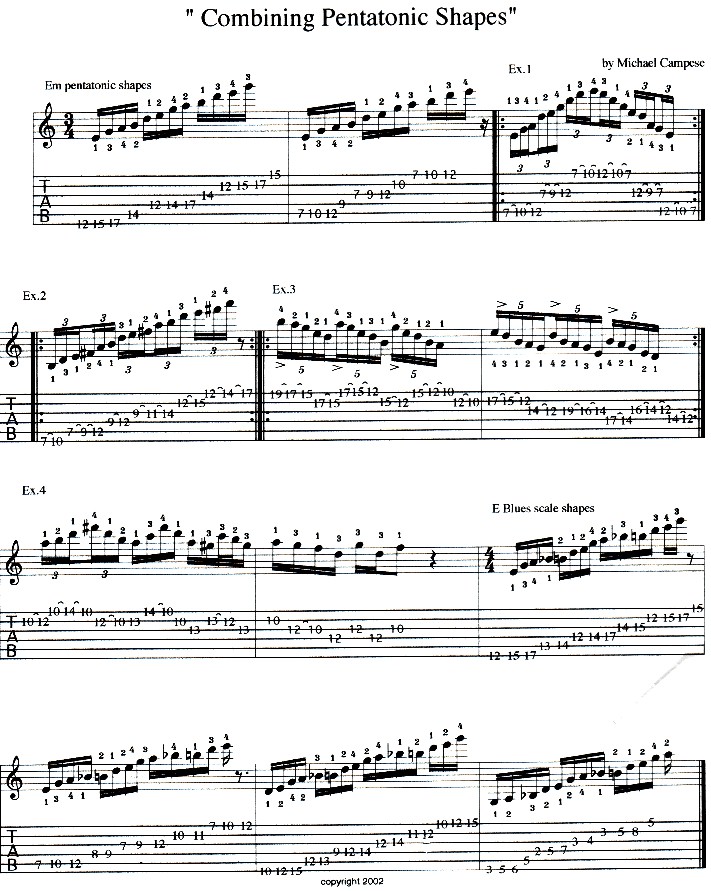Hello everyone! Welcome back! In the last lesson we talked about major scales and different ways to learn the neck. This time I'm going to show you a more modern approah to learning pentatonic/blues scales. We are going to combine the conventional pentatonic shapes together for more three note per string ideas. This should get you out of the old school approach to pentatonics.
Look at the first two shapes in Em pentatonic (E, G, A, B, D). The first one is in the 12th position and the second one is in the 7th position. All i did was combine the shapes together from the regular two note per string pentatonics. If you look at the first two patterns, you will notice three notes on one string then one note on the next string, three notes then one, etc. You can work out many other ways to play these; this is just one example. Try this on the whole neck. Let me give you some lines you can use this idea with.
Example 1 - This is a cool string skipping lick i like to use in Em pentatonic. We are only playing on the 1st, 3rd and 5th strings. Notice the lick is played with hammer-ons and pull-offs. But I really encourage you also to play the example picking all the notes. Make sure to follow the fingerings, and try moving this around the neck.
MP3 - Example 1
Example 2 - Here's a three octave Bm pentatonic idea (B, D, E, F#, A). We are just playing the scale across the neck, five notes at a time. By playing the scale this way we can fly across the fretboard real easily. Also, try playing this descending, and figure out the other positions to play the scale. Alternate pick this one too..
MP3 - Example 2
Example 3 - Here we have a pattern moving down the neck in groups of five notes. This is a little less common than, say , groups of four or six notes. We are in Em pentatonic here. Make sure you play this slowly and evenly, then gradually build up speed. I hope you have your metronome or drum machine on.
MP3 - Example 3
Example 4 - Now a little change of pace. This is a blues/fusion type lick. This is based on the D minor pentatonic/blues scale (D, F, G, Ab, A, C), with the added Major 6th - B, and the Major 3rd - F#. This is somthing i like to do to spice up pentatonics - add other notes to it, like the 3rd and 6th, etc. Try adding passing tones to the scales; you can get some cool sounds. Make sure you experiment.
MP3 - Example 4
Okay, now I will leave you with some blues scale shapes in different positions, using the same concepts. We only scratched the surface on this, so It's important to make up different patterns on your own. This will really help to learn your neck. Also, do this in all keys.

Don't forget, if you have any questions, feel free to email me. Stop by mikecampese.com for upcoming releases, etc. Check out my CDs "Full Circle" and "Total Freedom", and the other CDs on this site, if you have not yet.
Mike Campese is an all-around music performer, session artist and teacher competent in many musical styles, electric and acoustic. He has studied at G.I.T. (Honors Graduate), and with Paul Gilbert, Norman Brown, Stanley Jordan, Scott Henderson and Keith Wyatt.